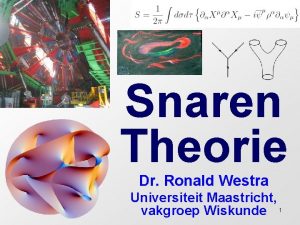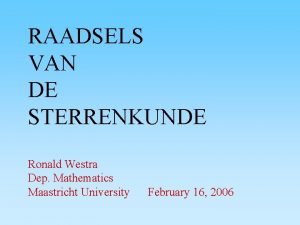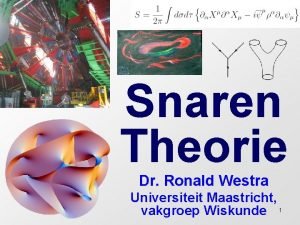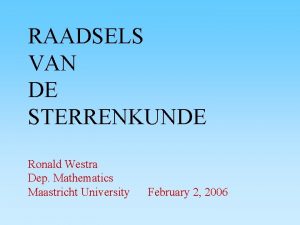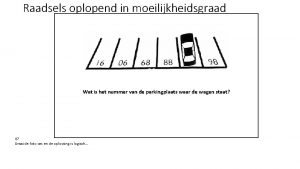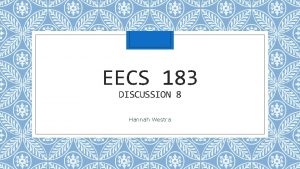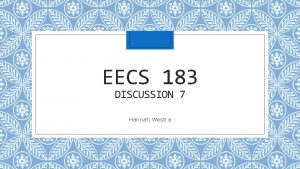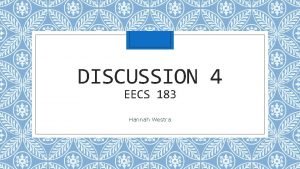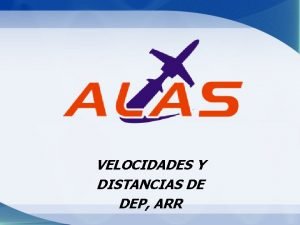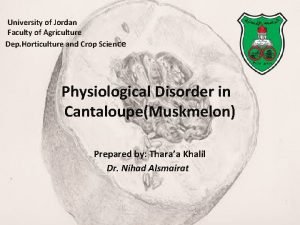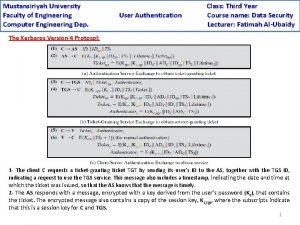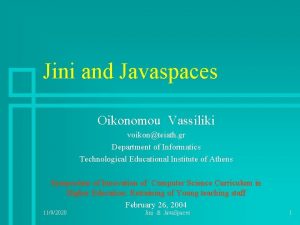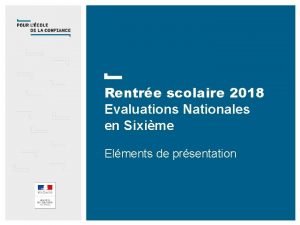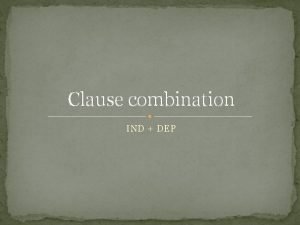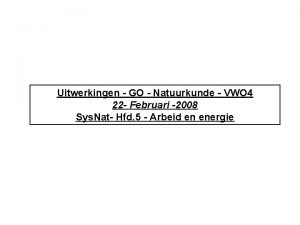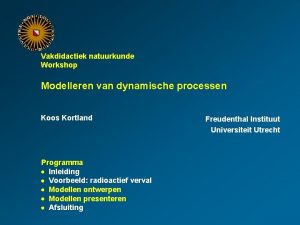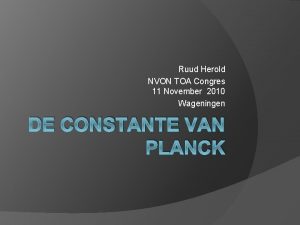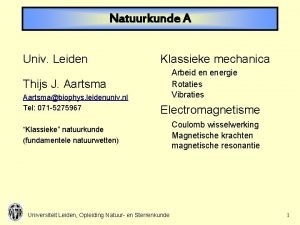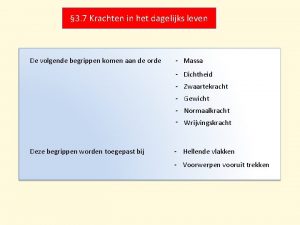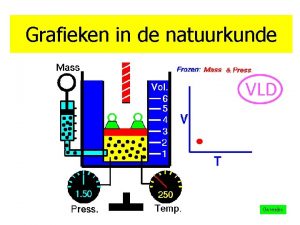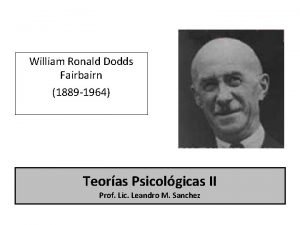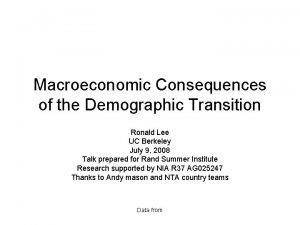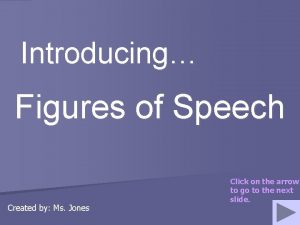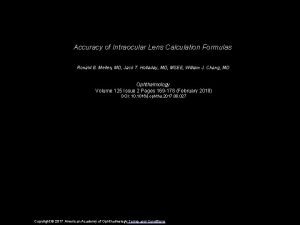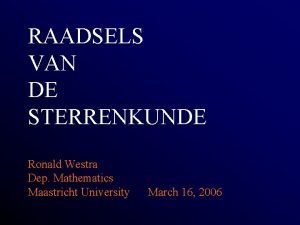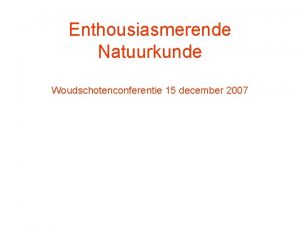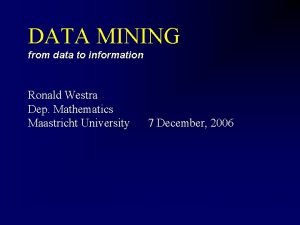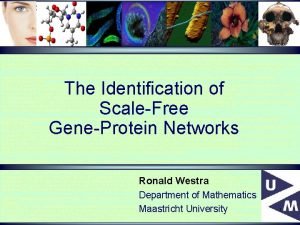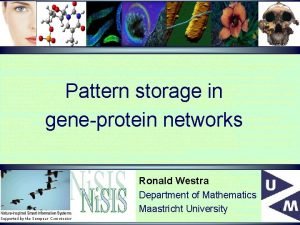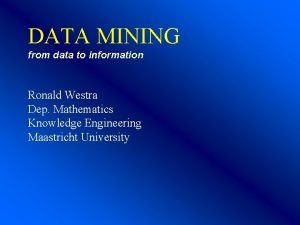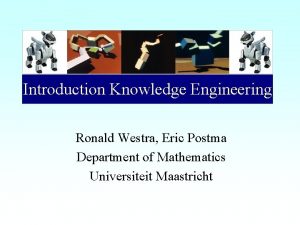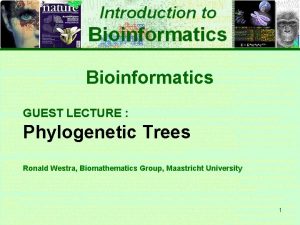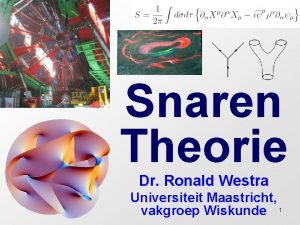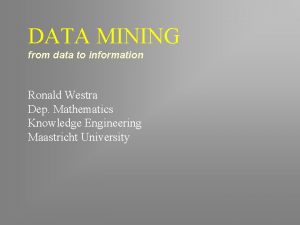RAADSELS VAN DE NATUURKUNDE Ronald Westra Dep Mathematics























































- Slides: 55

RAADSELS VAN DE NATUURKUNDE Ronald Westra Dep. Mathematics Maastricht University September 29, 2005

Deel 3 EINSTEIN vervolg

CPART III IInhoud De Algemene Relativiteitstheorie Zwarte gaten M De Big Bang

Speciale Relativiteit

De Speciale Relativiteitstheorie De drie postulaten van de relativiteitstheorie: RRelativiteitsprincipe: Natuurkundige wetten zijn in alle stelsels (coördinaten en klok waarmee iemand zijn waarnemingen doet) hetzelfde. LLichtpostulaat: De lichtsnelheid in het luchtledige is in ieder intertia stelsel (een stelsel waar geen krachten op werken) hetzelfde. Equivalentieprincipe: In vrije val bewegen alle objecten met dezelfde versnelling.

time: t’ time: t event space: x’ space: x

observer P 2 observer P 1 event E 1 P 1 -time t 1 event E 2 P 2 -time t 2

Algemene Relativiteitstheorie We are all agreed that your theory is crazy. The question which divides us is whether it is crazy enough. - Niels Bohr

Het Principe van Mach: De essentie van Mach's Principe is zoiets als: De inertie van een lichaam is bepaald in relatie tot alle andere lichamen in het universum (kortom: massa daar bepaald inertia hier). Maar "inertia" is hier dubbelzinnig: inertiele massa, of een eigenschap van de wet van inertia? Ernst Mach (1838 -1916)

Het Equivalentie-Principe Newtoniaanse mechanica Massa komt in twee contexten voor: 1. inertiele massa 2. zwaartekracht

VVolgens Newton T tijd t plaats x impuls p kracht F

Electrostatische kracht

Universele zwaartekracht G = 6. 67. 10 -11 m 3/kg. sec 2 Let op: hier staat m voor gravitationele massa

mi: inertial mass mg: zwaartekracht In principe is er geen enkele reden waarom beide ‘massa’s’gelijk zouden zijn! Echter is de valversnelling gelijk voor alle massa’s : Daarom is: g ~ mg/mi mg = m i

inertiele en zwaartekrachts massa

Het Equivalentie-Principe: Het equivalentie-principe werd geintroduceerd door Albert Einstein in 1907 toen hij de observatie maakte dat de valversnelling equivalent is aan de eenparige versnelling die ondervonden wordt in een raket in de vrije ruimte die versneld met 1 g (g=9. 81 m/s 2). Einstein formuleerde het aldus:

Het Equivalentie-Principe: We arrive at a very satisfactory interpretation of this law of experience, if we assume that the systems K and K' are physically exactly equivalent, that is, if we assume that we may just as well regard the system K as being in a space free from gravitational fields, if we then regard K as uniformly accelerated. This assumption of exact physical equivalence makes it impossible for us to speak of the absolute acceleration of the system of reference, just as the usual theory of relativity forbids us to talk of the absolute velocity of a system; and it makes the equal falling of all bodies in a gravitational field seem a matter of course. Einstein, 1911

Het ‘Sterke’ Equivalentie-Principe: The outcome of any local experiment, whether gravitational or not, in a laboratory moving in an inertial frame of reference is independent of velocity of the laboratory, or its location in spacetime.

Het ‘Sterke’ Equivalentie-Principe: The strong equivalence principle states that the results of any local experiment, gravitational or not, in an inertial frame of reference are independent of where and when in the universe it is conducted. This is the only form of the equivalence principle that applies to self-gravitating objects. It requires that the gravitational constant be the same everywhere in the universe. It is much more restrictive than the Einstein equivalence principle. General relativity is the only known theory of gravity compatible with this form of the equivalence principle.

Experimentele verfificatie van het Equivalentie-Principe:

Vroege Elementen in de Algemene Relativiteitstheorie: • Getijdenkrachten • Gravitationeel Doppler effect (Gravitational Red Shift) • Afbuiging van licht

Gravitationeel Doppler effect (Gravitational Red Shift)

Gravitational Red Shift Gravitational redshift in stars

Gravitational redshift The "applied side of general relativity" Corrections for gravitational redshift are nowadays common practice in many situations. We could almost call it "the applied side of General Relativity". With present-day accuracies, clocks in orbit around the Earth must be corrected for this effect. This is in particular the case with satellite-based navigational systems such as the Global Positioning System (GPS). To get accuracies of order 10 m, light travel times with an accuracy of order 30 ns (nanoseconds) have to be measured. Special-relativistic time dilatation (caused by the velocity) and gravitational redshift corrections in these satellites are of order 30000 ns per day.

Fundamentele incompatbiliteit Tot nu toe is er geen probleem om de simpele inertiaalstelsels van de speciale relativiteitstheorie te gebruiken Stel we hebben zo’n inertiaalstelsel G met een gravitioneel veld daarin met potentiaal Φ(x) Laat C een tweede waarnemer zijn op een plaats in ruimtetijd z C en G meten een andere waarde voor Φ(x) dus ΔΦ ≠ 0

Fundamentele incompatbiliteit Stel dat G een signaal uitzendt met lengte van t seconden. Als dit C bereikt is de lengte volgens de redenatie van de gravitationele roodverschuiving tot nu toe:

Fundamentele incompatbiliteit Nu een andere invalshoek: Volg de photonen eens in het Minkowski-diagram

Fundamentele incompatbiliteit ruimte C T photonen G t tijd

Fundamentele incompatbiliteit Minkowski geometrie eist: Gravitationele roodverschuiving eist:

Fundamentele incompatbiliteit DUS: We kunnen een gravitatieveld niet in een simpel inertiaalstelsel plaatsen. Ruimtetijd met zwaartekracht gehoorzaamt niet aan de wetten van Minkowski-metriek. Dit mogen we begrijpen als een manifestatie van de kromming van de ruimtetijd !!!

De betekenis van gekromde ruimte Als we een plat vlak (bv velletje papier) veranderen in een gekromd oppervlak (buigen om een grapefruit) gebeuren er twee dingen: * het buigt in de 3 D ruimte * het strekt elastisch uit

De betekenis van gekromde ruimte Dit is niet hetzelfde: Papier rollen tot cyllinder: alleen buigen geen strekken Trek aan vlak stuk rubber: alleen strekken geen buigen

De betekenis van gekromde ruimte We veronderstellen intuitief dat we voor buigen/oprollen een grotere ruimte nodig hebben: een dimensie meer

De betekenis van gekromde ruimte In de wiskunde en de natuurkunde hebben we die extra dimensie echter niet nodig! Theorema Egregium Vanuit deze visie is dat wat een oppervlak gekromd maakt het feit dat het niet als platte kaart kan worden weergegeven Dit was de oude kaartmakers al bekend:

De betekenis van gekromde ruimte

De betekenis van gekromde ruimte

Een nieuwe theorie voor zwaartekracht Nadat Einstein In 1916 de theorie had voltooid schreef hij een overzichts-artikel: The Foundation of the General Theory of Relativity.

Een nieuwe theorie voor zwaartekracht Einstein schrijft hierin over het incompatibiliteitsprobleem: When by the special theory of relativity I had arrived at the equivalence of all so-called inertial systems. . . the question whethere was not a further equivalence of coordinate systems followed naturally, to say the least of it. . . if only a relative meaning can be attached to the concept of velocity, ought we nevertheless to preserve in treating acceleration as an absolute concept?

Een nieuwe theorie voor zwaartekracht Einstein (vervolg): . . . physically speaking, the inertial system seemed to occupy a privileged position, which made the use of coordinate systems moving in other ways appear artificial.

Een nieuwe theorie voor zwaartekracht Mach's views were just those needed if special relativity were to be generalized, and Einstein adopted Mach's epistemological objection: Of all imaginable spaces. . . in any kind of motion relatively to one another, there is none which we may look upon as privileged a priori. . .

Een nieuwe theorie voor zwaartekracht Einstein then states a form of covariance principle which he seems to take as following in some unspecified wag from the above view: The laws of physics must be of such a nature that they apply to systems of reference in any kind of motion.

Een nieuwe theorie voor zwaartekracht This principle is extended to the following which Einstein refers to as the General Principle of Covariance: The general laws of nature are to be expressed by equations which hold good for all systems of coordinates, that is, are covariant with respect to any substitutions whatever.

Een nieuwe theorie voor zwaartekracht Einstein verder in The Foundation of the General Theory of Relativity : It will be seen from these reflections that in pursuing the general theory of relativity we shall be led to a theory of gravitation, since we are able to “produce” a gravitational field merely by changing the system of coordinates. identifying gravity with non-inertial systems, wholly reflects Einstein’s interpretation of gravity, the existence of which depends on the observer’s frame of reference.

Een nieuwe theorie voor zwaartekracht Voor zowel Einstein als Newton is het zwaartekrachtsveld iets dat objecten op een bepaalde manier doet bewegen. Voor Newton is dat veld een kracht-veld F(x) dat een beweging induceert op een zwaartekrachts-massa Voor Einstein is het veld geen kracht maar een kromming van ruimtetijd. De banen van de objecten zijn de kortste paden van in de gekromde ruimtetijd. Zwaartekracht is geen kracht maar een eigenschap van de gekromde ruimtetijd

Een nieuwe theorie voor zwaartekracht Voor Einstein vormen coordinatenstelsels van de gekromde ruimtetijd de sleutel naar de algemene relativiteitstheorie : Zwaartekracht versnelde beweging gekromde coordinaatselsels gekromde ruimtetijd

Een nieuwe theorie voor zwaartekracht Relativistische vergelijkingen voor het gravitatieveld :

spacetime is relative to the observer Causality is preserved but: Synchronity is lost

General Relativity Uniform acceleration is equivalent to a uniform gravity field. Spacetime deforms under the influence of mass and gravity and accelaration. In a gravitational field time proceeds faster compared to empty space


General Relativity Motion is defined by the curves that minimise the length of the trajectory (geodete) measured over spacetime Hence light is bend in gravitational fields



Zwarte gaten

General Relativity The set of equations for the propagation of spacetime indicates that a static universe is impossible : a universe containing mass must either expand or collapse. (Einstein not amused)

The Basis of Physics are Experiments and Observations Physical theories are not the reality, but a mathematical model that complies with all observations (following K. Popper).
 Snaar theorie
Snaar theorie Ronald westra
Ronald westra Snaar theorie
Snaar theorie Ronald westra
Ronald westra Raadsels met lucifers
Raadsels met lucifers Zonnedak westra
Zonnedak westra Project 3 eecs 183
Project 3 eecs 183 Hannah westra
Hannah westra Hannah westra
Hannah westra Ronald van marlen
Ronald van marlen Ronald van der horst
Ronald van der horst Dep arr
Dep arr Dep horticulture
Dep horticulture Depuser
Depuser Dep
Dep Cpu dep
Cpu dep Jini surrogate architecture
Jini surrogate architecture ıml32.dll indir
ıml32.dll indir Dep email
Dep email Dep environmental education grants
Dep environmental education grants Giô dép
Giô dép Eva.depp.taocloud
Eva.depp.taocloud Avt dep
Avt dep Dep hkps
Dep hkps Lis dep
Lis dep Dep training modules
Dep training modules Dep group
Dep group Bypass dep
Bypass dep Dep clause
Dep clause Ondervindt
Ondervindt Natuurkunde boek havo 4
Natuurkunde boek havo 4 Systematische natuurkunde havo 4
Systematische natuurkunde havo 4 Elektriciteit natuurkunde
Elektriciteit natuurkunde Hoe leer je natuurkunde
Hoe leer je natuurkunde Modelleren natuurkunde
Modelleren natuurkunde Significantie
Significantie Sprong bij volleybal natuurkunde
Sprong bij volleybal natuurkunde Woudschotenconferentie natuurkunde
Woudschotenconferentie natuurkunde Nico rutten
Nico rutten Nvon natuurkunde
Nvon natuurkunde Woudschoten natuurkunde
Woudschoten natuurkunde Hemelmechanica natuurkunde
Hemelmechanica natuurkunde Natuurkunde a
Natuurkunde a Wrijvingskracht berekenen helling
Wrijvingskracht berekenen helling Logaritmische schaal aflezen
Logaritmische schaal aflezen Internalizacio
Internalizacio Ronald lee in advancing
Ronald lee in advancing Example of personification
Example of personification Dr ronald arce
Dr ronald arce Ronald adams screenwriter
Ronald adams screenwriter Dr ronald melles
Dr ronald melles Fun facts about ronald reagan
Fun facts about ronald reagan Steve jobs steve wozniak and ronald wayne
Steve jobs steve wozniak and ronald wayne Patricia reilly wright
Patricia reilly wright Morrish real discipline
Morrish real discipline Mandy: “can i help you?” mandy wanted to know....
Mandy: “can i help you?” mandy wanted to know....
